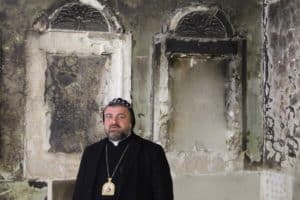In Syria, the passing of a fighter for hope
“A MAN WHO HAS SUFFERED WITH HIS PEOPLE and for his people.” This is the way Regina Lynch, project director of the Aid to the Church in Need (ACN), remembers Syrian Orthodox Archbishop Selwanos Boutros Alnemeh of Homs, who died Dec. 7 Damascus after a short illness.

“We extend our deepest sympathies to His Beatitude Patriarch Mar Ignatius Ephraim II, to the bishops of the Syrian Orthodox Church and to all the faithful of the Archdiocese of Homs, Hama, Tartous for this enormous loss,” said Ms. Lynch.
During ACN visits to Homs during the harshest periods of the war, the archbishop recounted: “I was raised an orphan; the Church was my mother. Now all of us in Syria feel like orphans.” His short life, which ended at age 52, was often accompanied by suffering. However, he transformed it into a paternal dedication, carrying out numerous projects to help orphans and the poorest families of the diocese, even at the height of the Syrian civil war. Another great concern of the archbishop were his priests, tireless pastors, but without any resources or means in a country devastated and mired in poverty.
He witnessed the destruction of Homs and the atrocities and persecution perpetrated by jihadists in different towns and Christian communities in the surrounding area. Of particular note was the massacre of 45 Christians in October 2013 in Sadad, the archbishop’s city of birth and now his final resting place. In May 2014, his brother was injured by a bomb that blew up the Homs cathedral. He died of his injuries last September.
Despite these heavy burdens, the metropolitan never stopped sowing hope. Along with emergency projects to alleviate suffering and need, with the help of ACN Bishop Selwanos promoted many projects to encourage the Christian community. One such initiative was the “Street of Hope” project, which invited the children of the Old Town of Homs to paint graffiti on the walls of the ruined houses, signifying that the Christians wanted to stay and rebuild that part of the city, which was destroyed during the war. Likewise, he was one of the first to promote the reconstruction of houses for those Christians who returned after the ceasefire and to request scholarships for students of all ages so that they could continue their studies as soon as possible. He also opened a nursery in Hama called “Hope of Life.”
His contribution and dedication in raising international awareness of the terrible situation in Syria was immense. For example, in 2016 he traveled with ACN to Geneva and Brussels to testify before the European Parliament about the reality Syrian Christians were living and to denounce the international negligence in the face of the disappearance of the Christian presence in Syria, due to persecution and the consequent emigration.
“It has been more than seven years of close collaboration and almost 40 projects that we have been able to carry out thanks to the commitment and dedication of Archbishop Selwanos during years of terrible suffering and war,” said Ms. Lynch, who added: “It is difficult to summarize all that work in a few words, but he was undoubtedly a pillar, a pillar of resistance against hopelessness and a fighter to save his people. He also was a true example of ecumenism. It is a great loss.”
—Maria Lozano

